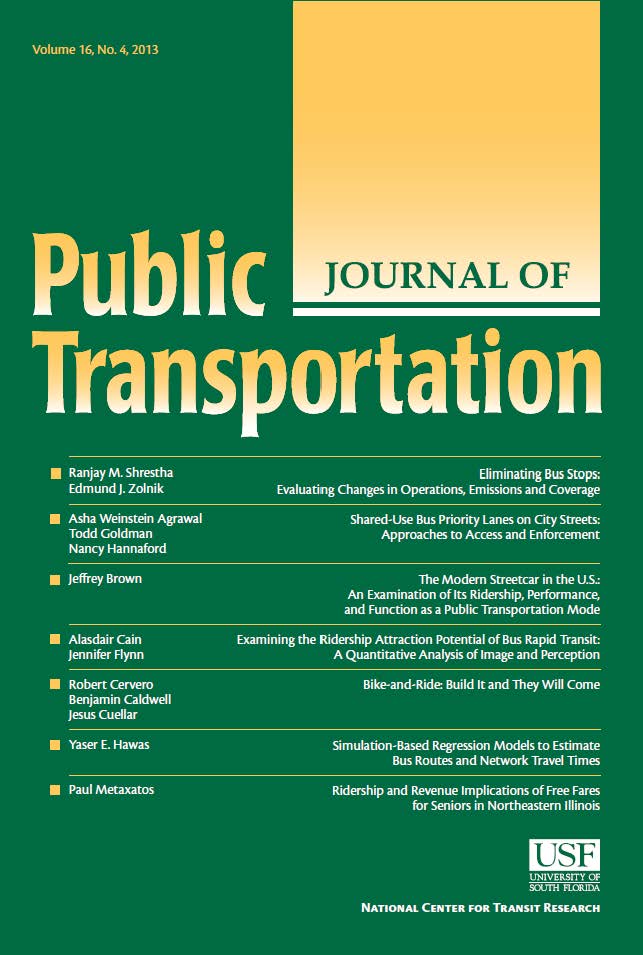从边缘到主流再回到主流?大流行驱动的美国免费公共交通演变的地理特征
IF 2
4区 工程技术
Q3 TRANSPORTATION
引用次数: 0
摘要
本文考察了美国在2019冠状病毒病大流行的头两年出人意料地采用免费公共交通(FFPT)政策。虽然卫生封锁导致流动性急剧减少,但必须维持安全的公共交通服务,以满足“基本工作人员”的需求。为了实现这一目标,许多城市交通机构采用了FFPT。为了研究大流行期间PT在哪里免费,我们根据来自美国近400个城市ta的信息建立并分析了一个新的数据集。我们的研究结果表明,在大流行期间,城市地区三分之二的公共交通服务选择暂停收费,分析发现,除了大流行前存在的29例完全FFPT病例外,还有73例完全FFPT病例。FFPT出现在人口和经济状况各不相同的地区。民主党支持率较高的地方更有可能取消收费并维持暂停收费,而拥有大量车队的大型运输机构往往会更快地恢复收费。这些调查结果突出表明,为应对这一流行病,影响FFPT方案的采用和持续时间的复杂因素,并强调了PT政策在应对过程中的适应性。总之,我们观察到FFPT已经从政策边缘转变为主流,从一个高度争议的措施转变为一个被广泛接受的策略。尽管在大流行的最初几波之后,FFPT病例数量显著减少,但仍远高于大流行前的水平,有40个TAs继续提供免费服务。本文章由计算机程序翻译,如有差异,请以英文原文为准。
From the fringes to the mainstream and back? The geography of pandemic-driven evolution of fare-free public transport in the United States
The article examines the surprising uptake of the fare-free public transport (FFPT) policy in the United States during the first two years of the COVID-19 pandemic. While sanitary lockdowns led to a drastic reduction of mobility, safe public transport (PT) services had to be maintained to cater for “essential workers”. To achieve this, many urban transit agencies (TAs) adopted FFPT. To examine where PT became fare-free during the pandemic, we built and analysed a new dataset based on information from nearly 400 urban TAs across the US. Our findings indicate that two-thirds of the public TAs in urban areas opted to suspend fare collection amid the pandemic, with the analysis uncovering 73 cases of full FFPT on top of the 29 that had existed before the pandemic. FFPT emerged in areas with diverse demographic and economic profiles. Localities with higher Democratic Party support were more likely to abolish fares and sustain the suspensions, while larger transit agencies with substantial vehicle fleets tended to resume fare collection sooner. These findings highlight the complex factors influencing the adoption and duration of FFPT programmes in response to the pandemic, and underscore the adaptability of PT policies in the response. In sum, we observe that FFPT has shifted from the policy margins to the mainstream, having transformed from a highly controversial measure to a widely accepted strategy. Although the number of FFPT cases decreased significantly after the initial waves of the pandemic, it nonetheless remained much higher than pre-pandemic levels, with 40 TAs continuing to offer fare-free services.
求助全文
通过发布文献求助,成功后即可免费获取论文全文。
去求助
来源期刊

Journal of Public Transportation
TRANSPORTATION-
CiteScore
6.40
自引率
0.00%
发文量
29
审稿时长
26 days
期刊介绍:
The Journal of Public Transportation, affiliated with the Center for Urban Transportation Research, is an international peer-reviewed open access journal focused on various forms of public transportation. It publishes original research from diverse academic disciplines, including engineering, economics, planning, and policy, emphasizing innovative solutions to transportation challenges. Content covers mobility services available to the general public, such as line-based services and shared fleets, offering insights beneficial to passengers, agencies, service providers, and communities.
 求助内容:
求助内容: 应助结果提醒方式:
应助结果提醒方式:


